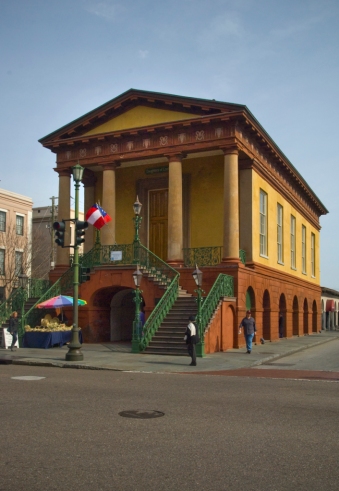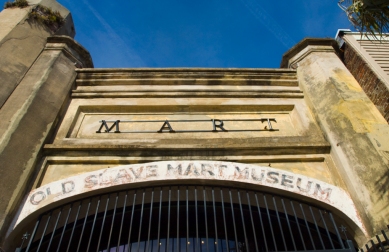Built in 1841, Market Hall is a Roman Revival building that has brownstone and bronze friezes of rams and oxens to indicate it’s proximity to meat market over which it used to seat.
St. Philip’s was organized in 1680. The credentials and character of early Church of England clergyman was dubious. The first pastor of St. Philips was censured for baptizing a bear cub at a drunken ceremony. John C. Calhoun, neither a Charlestonian or a church member, is buried here. After having his body on display for three weeks his plantation was considered too remote to transport it!
Built in 1694, the Pink House was first a tavern and then a brothel. In the 18th century Chalmers Street was the center of Charleston’s red light district.
Now a museum, 6 Chalmers Street was the Slave Auction Mart established after an 1856 ordinance prohibited street auctions. Slaves were generally brought here from great distances, either by ship, cattle train or on foot. They were keep here for weeks to be fattened up prior to the sale. In the back were livestock type pens in which the slaves were shackled. Each had a loose curtain on the front to prevent potential buyers from perusing them before they were restored to health. Slaves would attempt to interact with the buyers, trying to tell owners, with good reputations, about their good work habits and, conversely, trying to dissuade cruel owners from purchasing them. Another constant plea was to not break up families.
The street is named after Dr. Lionel Chalmers who, along with other Edinburgh physicians, had to battle ignorance as well as rampant epidemics. A popular smallpox cure of the day was to place the patient’s feet into the abdominal cavity of an incised fowl while applying a mixture of honey and “dry white dog dung” to the throat! Sure, that’ll work.
The Old Exchange, 1771, is the last British constructed building in America. The Declaration of Independence was read to an exuberant crowd of rebels from these steps in 1776.
While on a tour of the newly formed states, George Washington was entertained in this room in 1791.









Enjoyed your comments about the Holy City, photos as well. I’m just about to move down there (after 40 years in Manhattan); my ancestors were Scots merchants in Tradd Street in the 18th century. Absolutely beautiful city. Next time, visit Middleton Plantation (and Drayton Hall along the way): much more authentic, and “alive”. The descendants live on the third floor of the Edmundston-Allston House on the Battery; an absolute MUST for visitors. You’re right: I’ve been there a dozen times and still discover things. But thanks- interesting reading about Dr Chalmers, as I am living in ‘his’ street…slightly (one block) north of Broad as Charlestonians say!